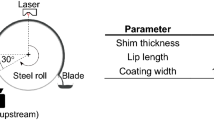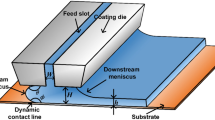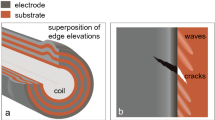Abstract
Slot coating is commonly used in lithium-ion battery electrode manufacturing. As the coating flow stability is sensitive to the processing conditions and physical properties of the coating solution, various studies have been conducted to obtain stable coating conditions with a battery slurry. However, there are some limitations to using the slurry in coating experiments. For instance, the opacity of the slurry poses a challenge to the visualization of the slurry coating. Herein, we propose a carboxymethyl cellulose (CMC) solution as a candidate for battery anode slurry for coating flows. Because a model fluid may not cover all rheological properties of the anode slurry, we focused on the high-shear viscosity with respect to the characteristics of the coating flows. The rheological properties of the slurry and model fluid were measured. To compare the coating flow at high-shear conditions, a computational analysis of the coating flow was conducted. Although the flow curves of the slurry and model fluid show slight deviations, the computed velocity profile of the model fluid is similar to that of the slurry. Furthermore, blade coating with the slurry and model fluid at a shear rate of 5000 s−1, produced a comparable coating thickness. Consequently, the CMC solution has proven to be a valuable candidate for experimental research on the coating flow of battery anode slurries.






Similar content being viewed by others
References
Li J, Fleetwood J, Hawley WB, Kays W (2022) From materials to cell: state-of-the-art and prospective technologies for lithium-ion battery electrode processing. Chem Rev 122:903–956. https://doi.org/10.1021/acs.chemrev.1c00565
Du C-F, Liang Q, Luo Y et al (2017) Recent advances in printable secondary batteries. J Mater Chem A 5:22442–22458. https://doi.org/10.1039/c7ta07856k
Saraka RM, Morelly SL, Tang MH, Alvarez NJ (2020) Correlating processing conditions to short- and long-range order in coating and drying lithium-ion batteries. Acs Appl Energy Mater 3:11681–11689. https://doi.org/10.1021/acsaem.0c01305
Ding X, Liu J, Harris TAL (2016) A review of the operating limits in slot die coating processes. Aiche J 62:2508–2524. https://doi.org/10.1002/aic.15268
Higgins BG, Scriven LE (1980) Capillary pressure and viscous pressure drop set bounds on coating bead operability. Chem Eng Sci 35:673–682. https://doi.org/10.1016/0009-2509(80)80018-2
Ruschak KJ (1976) Limiting flow in a pre-metered coating device. Chem Eng Sci 31:1057–1060. https://doi.org/10.1016/0009-2509(76)87026-1
Carvalho MS, Kheshgi HS (2000) Low-flow limit in slot coating: theory and experiments. Aiche J 46:1907–1917. https://doi.org/10.1002/aic.690461003
Romero OJ, Scriven LE, Carvalho MS (2006) Slot coating of mildly viscoelastic liquids. J Non-newton Fluid 138:63–75. https://doi.org/10.1016/j.jnnfm.2005.11.010
Romero OJ, Suszynski WJ, Scriven LE, Carvalho MS (2004) Low-flow limit in slot coating of dilute solutions of high molecular weight polymer. J Non-newton Fluid 118:137–156. https://doi.org/10.1016/j.jnnfm.2004.03.004
Siqueira IR, Carvalho MS (2019) A computational study of the effect of particle migration on the low-flow limit in slot coating of particle suspensions. J Coat Technol Res 16:1619–1628. https://doi.org/10.1007/s11998-019-00196-4
Nam J, Carvalho MS (2011) Flow visualization and operating limits of tensioned-web-over slot die coating process. Chem Eng Process Process Intensif 50:471–477. https://doi.org/10.1016/j.cep.2010.09.005
Jeong T-J, Prasath RGR, Sitaraman SK, Harris TAL (2020) Visualization of delamination in encapsulated flexible electronics fabricated using slot die coating. J Electron Mater 49:3332–3339. https://doi.org/10.1007/s11664-020-08065-2
Hong H, Nam J (2017) Automatic detection of contact lines in slot coating flows. Aiche J 63:2440–2450. https://doi.org/10.1002/aic.15612
Clarke A (1995) The application of particle tracking velocimetry and flow visualisation to curtain coating. Chem Eng Sci 50:2397–2407. https://doi.org/10.1016/0009-2509(95)00036-5
Kim D, Park J, Nam J (2021) Analysis of flow and slip behavior of microgel solution inside microchannel. Chem Eng Sci. https://doi.org/10.1016/j.ces.2021.116972
Sato Y, Irisawa G, Ishizuka M et al (2003) Visualization of convective mixing in microchannel by fluorescence imaging. Meas Sci Technol 14:114. https://doi.org/10.1088/0957-0233/14/1/317
Sinton D (2004) Microscale flow visualization. Microfluid Nanofluid 1(1):2–21. https://doi.org/10.1007/s10404-004-0009-4
Kwon YI, Kim JD, Song YS (2015) Agitation effect on the rheological behavior of lithium-ion battery slurries. J Electron Mater 44:475–481. https://doi.org/10.1007/s11664-014-3349-1
Park JH, Sung SH, Kim S, Ahn KH (2022) Significant agglomeration of conductive materials and the dispersion state change of the Ni-rich NMC-based cathode slurry during storage. Ind Eng Chem Res 61:2100–2109. https://doi.org/10.1021/acs.iecr.1c04205
Liu D, Chen L-C, Liu T-J et al (2014) An effective mixing for lithium ion battery slurries. Adv Chem Eng Sci 04:515–528. https://doi.org/10.4236/aces.2014.44053
Arancibia C, Navarro-Lisboa R, Zúñiga RN, Matiacevich S (2016) Application of CMC as thickener on nanoemulsions based on olive oil: physical properties and stability. Int J Polym Sci 2016:1–10. https://doi.org/10.1155/2016/6280581
Middleman (1998) An introduction to fluid dynamics principles of analysis and design. Wiley, Australia
Gordon R, Orias R, Willenbacher N (2020) Effect of carboxymethyl cellulose on the flow behavior of lithium-ion battery anode slurries and the electrical as well as mechanical properties of corresponding dry layers. J Mater Sci 55:15867–15881. https://doi.org/10.1007/s10853-020-05122-3
Lestriez B (2010) Functions of polymers in composite electrodes of lithium ion batteries. Cr Chim 13:1341–1350. https://doi.org/10.1016/j.crci.2010.01.018
Lim S, Kim S, Ahn KH, Lee SJ (2015) The effect of binders on the rheological properties and the microstructure formation of lithium-ion battery anode slurries. J Power Sources 299:221–230. https://doi.org/10.1016/j.jpowsour.2015.09.009
Lee J-H, Paik U, Hackley VA, Choi Y-M (2005) Effect of carboxymethyl cellulose on aqueous processing of natural graphite negative electrodes and their electrochemical performance for lithium batteries. J Electrochem Soc 152:A1763. https://doi.org/10.1149/1.1979214
Carnali JO, Naser MS (1992) The use of dilute solution viscometry to characterize the network properties of carbopol microgels. Colloid Polym Sci 270:183–193. https://doi.org/10.1007/bf00652185
Varges PR, Costa CM, Fonseca BS et al (2019) Rheological characterization of carbopol® dispersions in water and in water/glycerol solutions. Fluids 4:3. https://doi.org/10.3390/fluids4010003
Denn MM, Bonn D (2011) Issues in the flow of yield-stress liquids. Rheol Acta 50:307–315. https://doi.org/10.1007/s00397-010-0504-3
Bajaj M, Prakash JR, Pasquali M (2008) A computational study of the effect of viscoelasticity on slot coating flow of dilute polymer solutions. J Non-newton Fluid 149:104–123. https://doi.org/10.1016/j.jnnfm.2007.05.013
Olsson F, Isaksson P (1995) The influence of viscoelastic rheology on blade coating as revealed by numerical methods. Nord Pulp Paper Res 10:234–244. https://doi.org/10.3183/npprj-1995-10-04-p234-244
Ray SS (2006) Rheology of polymer/layered silicate nanocomposites. J Ind Eng Chem 12:811–842
Kwak H, Nam J (2020) Simple criterion for vortex formation in the channel flow of power-law fluids. J Non-newton Fluid 284:104372. https://doi.org/10.1016/j.jnnfm.2020.104372
White FM, Majdalani J (2006) Viscous fluid flow. McGraw-Hill, New York
Weinstein SJ, Ruschak KJ (2004) Coating flows. Annu Rev Fluid Mech 36:29–53. https://doi.org/10.1146/annurev.fluid.36.050802.122049
Sullivan TM, Middleman S (1986) Film thickness in blade coating of viscous and viscoelastic liquids. J Non-newton Fluid 21:13–38. https://doi.org/10.1016/0377-0257(86)80060-x
Acknowledgements
This work was supported by the National Research Foundation of Korea (NRF) grant funded by the Korean government (Ministry of Science and ICT, MSIT) (Nos. NRF-2018R1A5A1024127, NRF-2020R1A2C2008141, and NRF-2021M3H4A6A01041234). Also, the Institute of Engineering Research at Seoul National University provided research facilities for this work.
Author information
Authors and Affiliations
Corresponding author
Additional information
Handling Editor: M. Grant Norton.
Publisher's Note
Springer Nature remains neutral with regard to jurisdictional claims in published maps and institutional affiliations.
Supplementary Information
Below is the link to the electronic supplementary material.
Rights and permissions
Springer Nature or its licensor holds exclusive rights to this article under a publishing agreement with the author(s) or other rightsholder(s); author self-archiving of the accepted manuscript version of this article is solely governed by the terms of such publishing agreement and applicable law.
About this article
Cite this article
Lee, M., Jung, H., Lee, M. et al. Model fluid for coating flows of Li-ion battery anode slurry. J Mater Sci 57, 17935–17945 (2022). https://doi.org/10.1007/s10853-022-07615-9
Received:
Accepted:
Published:
Issue Date:
DOI: https://doi.org/10.1007/s10853-022-07615-9




